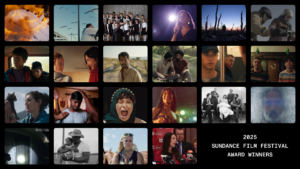Eric Hynes
This story was originally published January 25, 2017, following the premiere of Manifesto at the 2017 Sundance Film Festival. The film is currently screening at Film Forum in NYC.
In her latest film, Cate Blanchett plays a choreographer. And also a puppeteer. And also a schoolteacher, a scientist, a newscaster, a punk rocker, a day trader — and shall we go on? Julian Rosefeldt’s Manifesto demands 13 different parts from virtuoso Blanchett, who takes on different accents, costumes, and makeup for each. It’s a remarkable feat of acting, but equally remarkable is the text that she’s serving. Each of the 13 characters represents and recites a distinct and canny collage of 20th-century art manifestos, from pop art to Fluxus, Dadaism to film, and each episode is set against a unique and provocative Berlin environment. After appearing as an art installation, most recently at the Armory in New York City, Rosefeldt refashioned the project as a feature film, which debuted at the Festival on Monday afternoon at the Library Theatre.
“I didn’t cast Cate Blanchett for this project,” Rosefeldt said during the post-screening Q&A. “We ran into each other six years ago at an art opening of my work, and we started to talk. She said, ‘Why don’t we do something together?’ You can imagine my reaction. It took me another two-and-a-half years until we finally started to talk about Manifesto. The only thing I told Cate is that she would do many characters. We bargained — she said, ‘Can we do six or seven?’ And I said, ‘Can you do twenty?’ We ended up with thirteen. We had two weeks to shoot this — it was a fantastic trip. And now I believe she could do Mike Tyson.”

Rosefeldt spoke of the verve and passion of the manifestos chosen for the script and offered up an interesting context for texts from artists and thinkers such as John Reed, Dziga Vertov, Paul Eluard, André Breton, and Lars von Trier. “I’m an artist myself, and I know that what we say, we don’t always mean it that seriously,” he said. “Keep in mind that these texts were written when the artists had hardly left their parents’ house — they were 21, 22. And at that time of your life you’re very insecure. You’re trying to tell yourself who you are and what you stand for. And because you’re insecure you shout very loudly, and with all this anger. You pretend to have a lot of security but you actually don’t.”
The director talked about the various ways in which he matched text with character and location. Sometimes it was about finding a contemporary analogue — the hyperspeed of online trading with futurism, for example. And sometimes it was pairing opposites, with a traditional nuclear family reciting Claes Oldenburg’s funny and profane “I Am for an Art …” at dinnertime prayer. “You put two elements together that aren’t necessarily friends and then you see what the chemistry does,” he said. Rosefeldt admitted that of all of the texts, he felt most closely aligned with Jim Jarmusch’s ironically titled “Golden Rules of Filmmaking.” Jarmusch’s slogan “Nothing Is Original,” as well as the notion that all art borrows from other art, is a useful guide to “the basic spirit of the entire thing,” he said of Manifesto, “and of life itself.”




